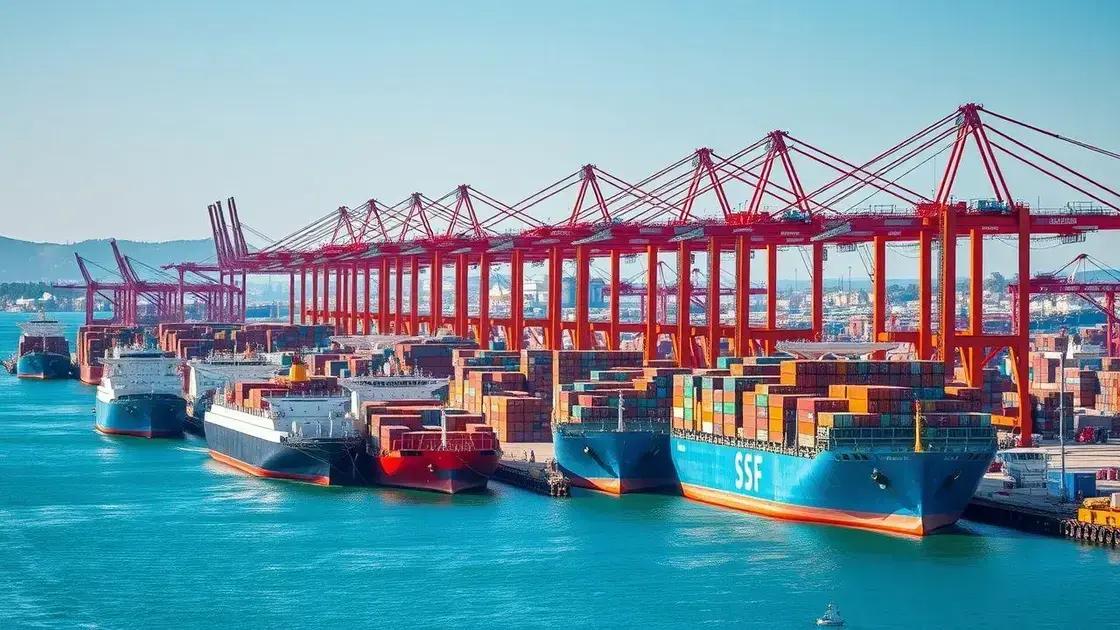Declining demand impacts U.S. international tourism

Anúncios
Declining demand impacts U.S. international tourism due to economic challenges, health concerns, and shifting traveler preferences, necessitating strategic adaptations by the industry to attract visitors and ensure recovery.
Declining demand impacts U.S. international tourism, and it raises important questions about the future of travel. Have you noticed fewer foreign tourists in your city? This article explores the underlying causes and what it means for our economy.
Anúncios
Current trends in international tourism
Current trends in international tourism reflect changing behaviors and preferences among travelers worldwide. Understanding these trends is essential for businesses and destinations aiming to adapt and thrive.
Rise of Sustainable Tourism
More travelers are prioritizing sustainability. They seek eco-friendly options, from hotels to activities, reducing their environmental impact. Businesses are responding by offering green initiatives and promoting local culture.
Anúncios
Technology’s Role in Travel
Technology continues to shape how we travel. Mobile apps, online booking, and virtual tours enhance the tourist experience, making travel planning easier than ever. Furthermore, innovations like AI and data analytics help companies better understand customer preferences.
- Increased use of mobile payment options
- Growth of online travel agencies (OTAs)
- Popularity of personalized travel experiences
Another key trend is the demand for personalized travel experiences. Tourists today want unique and customized itineraries, often curated to their interests. This might include niche tours, like culinary adventures or wellness retreats, to create lasting memories.
Changing Demographics of Travelers
Travelers have also changed over the years. Baby boomers are exploring destinations they once overlooked, while millennials crave adventure and unique experiences. Each cohort brings different expectations that shape the industry.
- Increased travel among older adults
- Desire for affordable luxury among millennials
- Gen Z preferences for social media-worthy experiences
As the market evolves, understanding these changes is crucial for stakeholders in the tourism sector. Adapting to these new trends can ensure sustainability and growth in an ever-competitive environment.
By embracing these trends, businesses can position themselves for success in the shifting landscape of international tourism.
Key factors driving declining demand
Key factors driving declining demand in U.S. international tourism can be traced to various economic, social, and environmental influences. Understanding these factors is crucial for stakeholders aiming to adapt to this shifting landscape.
Economic Challenges
The economy plays a significant role in tourism. Global economic downturns often lead to reduced disposable income, causing travelers to prioritize essential spending over vacations. Furthermore, inflation has raised prices on travel-related costs, which can deter potential tourists. As people’s budgets tighten, fewer choose the U.S. as their travel destination.
Health and Safety Concerns
Health and safety have become pressing concerns since the pandemic. Many international travelers remain cautious about potential health risks during their trips. Travel restrictions and vaccination requirements can complicate plans, leading to reservations about visiting the U.S. These concerns directly impact decisions regarding travel.
Changing Travel Preferences
Travel preferences have evolved. Today’s travelers seek experiences that align with their values. There has been a noticeable shift towards localism, where tourists choose destinations closer to home to reduce travel time and environmental impact. This can make international travel less appealing, especially to countries like the U.S.
- Growth of remote work allows for more local travel
- Increased interest in domestic tourism options
- Prioritization of wellness and outdoor activities
Additionally, younger generations often favor adventures that immerse them in different cultures, leading them to destinations other than traditional tourist hotspots. Such shifts in preferences can contribute to declining demand for U.S. international tourism.
Lastly, geopolitical situations and natural disasters also play a pivotal role. Events that create insecurity or instability can deter travelers. The combination of these factors creates a challenging environment for tourism, necessitating strategic responses from businesses and policymakers.
Impacts on the U.S. economy

Impacts on the U.S. economy from declining international tourism are significant and far-reaching. As the flow of tourists decreases, businesses that rely on foreign visitors face challenging times.
Loss of Revenue for Businesses
Travelers contribute to various sectors, including hospitality, retail, and entertainment. As international tourists spend less, the revenue for hotels, restaurants, and attractions decreases. This loss can lead to layoffs and even closures, affecting local economies.
Decrease in Job Opportunities
The tourism industry supports millions of jobs in the U.S. A decline in international visitors can result in fewer job opportunities. Many people depend on tourism for their livelihoods, making this a vital issue for communities.
- Impact on frontline service jobs
- Reduced hours for seasonal workers
- Economic ripple effect on local suppliers
As job opportunities diminish, areas that depend heavily on tourism may experience higher unemployment rates. This can further strain local economies and public services.
Effects on Local Infrastructure
Tourism often drives investments in infrastructure, such as airports, roads, and public transportation. With reduced demand, funding for these projects may decline, leading to less maintenance and deterioration of essential services. As a result, local residents and remaining tourists can face inconveniences or safety concerns.
In addition, the tax revenue generated from tourism supports public services like schools and healthcare. A drop in tourist spending translates into less funding for these essential services. Thus, the entire community can feel the negative impact.
To counter these challenges, policymakers need to develop strategies aimed at revitalizing the tourism sector. Identifying ways to attract more visitors and enhance visitor experiences could help reverse some of these economic downturns.
Strategies for recovery in tourism
Strategies for recovery in tourism are essential to address the declining demand for U.S. international tourism. With changes in traveler behavior and preferences, businesses and governments need to adopt new approaches to attract visitors.
Investing in Marketing and Promotion
One of the first steps is to increase marketing efforts targeted at potential travelers. Highlighting unique attractions and cultural experiences can draw interest. Social media campaigns and partnerships with influencers can effectively reach younger audiences.
Enhancing Visitor Experience
Improving the overall visitor experience can make a significant difference. Offering personalized services and ensuring safety can help build traveler confidence. Businesses should focus on providing memorable experiences that encourage repeat visits.
- Implementing virtual tours to showcase offerings
- Creating loyalty programs to enhance customer retention
- Offering special promotions for off-peak seasons
Another strategy is enhancing the digital experience. Travelers increasingly rely on technology for planning and booking. Ensuring that websites are user-friendly and that information is easily accessible can help attract tech-savvy visitors.
Fostering Collaboration Among Stakeholders
Collaboration among stakeholders is crucial. The tourism sector can benefit from working with local governments, businesses, and communities. Creating joint marketing initiatives can pool resources and maximize outreach efforts. Partnerships with airlines and travel agencies can also create attractive packages for tourists.
Additionally, understanding traveler sentiment and adapting to emerging trends can guide recovery efforts. Focusing on sustainability and responsible tourism can appeal to eco-conscious travelers and enhance the destination’s reputation.
By adopting these strategies, the tourism industry can work towards reviving interest, improving experiences, and ultimately recovering from the impacts of declining demand.
Future predictions for travel industries
Future predictions for travel industries suggest a landscape that is continuously evolving. As travelers’ preferences change, the industry must adapt to remain relevant and competitive.
Shift Towards Sustainable Practices
One notable trend is the growing shift towards sustainability. Tourists are increasingly concerned about their environmental impact. As a result, travel companies will need to prioritize eco-friendly practices in their operations. This includes sustainable accommodations, carbon offset programs, and travel experiences that promote conservation.
Embrace of Technology
Technology will continue to transform the travel industry. Innovations such as artificial intelligence and machine learning will enhance personalization for travelers. Customers will receive tailor-made suggestions based on their preferences, making planning easier and more efficient.
- Chatbots for customer service and bookings
- Augmented reality for enhanced travel experiences
- Mobile apps for seamless travel management
Additionally, contactless technology and digital health passes may become standard as health becomes a top priority for travelers. Innovations in travel tech will be vital in creating a safe and enjoyable experience for customers.
Shifting Demographics
As demographics change, the travel industry will see different generations influencing travel trends. Older generations may seek more comfortable and organized travel experiences, while younger travelers may prefer adventure and unique cultural interactions. Businesses need to tailor their offerings to meet these diverse expectations.
Furthermore, the rise of remote work is likely to blur the lines between business and leisure travel. More people may choose to work from anywhere, leading to a rise in workcation options. This trend can create new opportunities for the tourism industry.
Overall, flexibility and innovation will be crucial for surviving in the future travel landscape. By embracing changes and addressing emerging trends, the travel industry can create lasting connections with future generations of travelers.
FAQ – Frequently Asked Questions About Declining Demand in U.S. International Tourism
What are the main factors affecting U.S. international tourism?
Key factors include economic challenges, health and safety concerns, changing travel preferences, and geopolitical situations.
How can the tourism industry adapt to changing traveler preferences?
The industry can focus on improving sustainability, leveraging technology for personalization, and offering unique travel experiences that align with current trends.
What strategies can help revive the tourism sector?
Strategies include increasing marketing efforts, enhancing visitor experiences, fostering collaboration among stakeholders, and embracing digital innovations.
What does the future of the travel industry look like?
The future will likely see a greater emphasis on sustainable practices, advancements in technology, and changing demographics impacting travel preferences.






